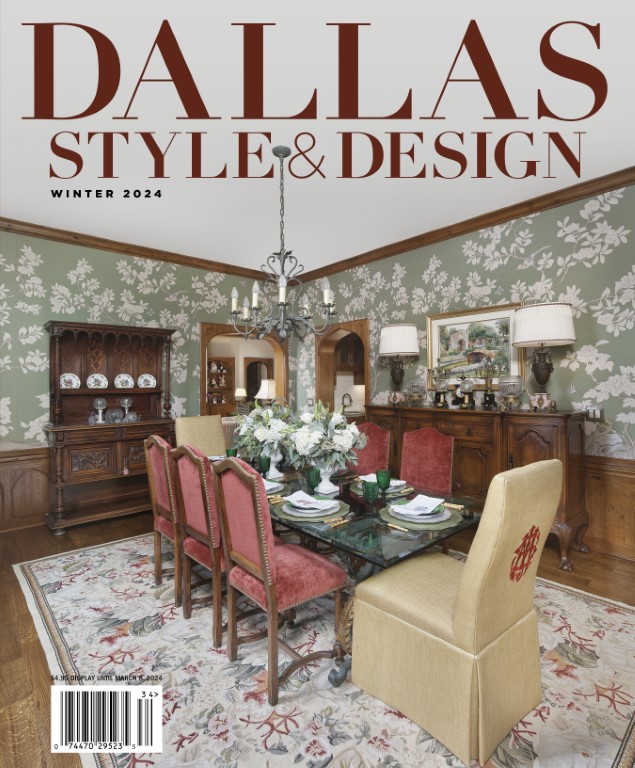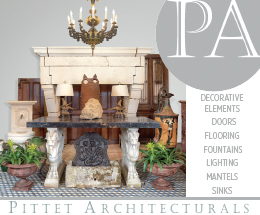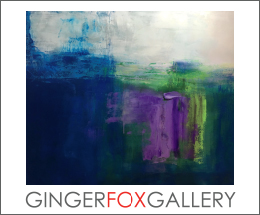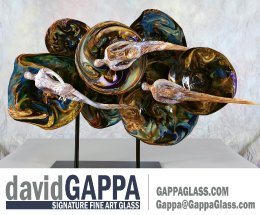All aspects of life ebb and flow through different cycles. Fashion has seasons, furniture design has trends, architecture has periods. Art collecting is currently experiencing a movement toward the abstract and contemporary. Artists such as Tony Collins, Paula Radvansky, William Hall and many others are enjoying an interest in their work like never before, from collectors as well as designers.
Technology is also changing the way galleries and artists interact with collectors. Social media has become the go-to platform for artists to interact directly with collectors and patrons, while galleries are able to use social media and websites to keep clients and collectors updated on a minute-by-minute basis, if they desire.
An online presence is as important as a good show in a physical gallery but provides more timely interaction and can be enhanced with video chatting and one-on-one interaction directly between artist and collector, which can often be impossible at a show opening.
Dallas Style & Design spoke with gallery owners and artists to learn their perspectives and experiences with art collectors this past year and what we might foresee in the future.
Laura Rathe Fine Art
Laura Rathe is one of the first to admit that collectors are gravitating toward contemporary art versus traditional. “They enjoy seeing new media being used in unique ways and tend to look for distinctive works of art that will incorporate color and design. We are seeing more homes with neutral color palettes and minimal furniture, so the clients want the art to do the talking!” Rathe says.
The gallery is continuously keeping up with this trend and expanding its roster to bring the very best art that it knows its patrons will love, including the introduction of artists such as Chris Wood, Hunt Rettig and Dylan Gebbia-Richards in 2018.
Rathe also notes how important technology is to galleries today. “Technology has truly changed the way we work with collectors,” she says. “Art is now accessible at our fingertips and has opened up communication with collectors all over the world.”
Laura Rathe Fine Art
Paula Radvansky
An online presence offers the ability to be in constant communication with a patron who cannot make it to the gallery. It also offers a direct channel for education. “It’s important to keep the conversation open and educate both collectors and art appreciators on the ever-changing art world. There is nothing we love more than conversing and informing others about art!” Rathe says.
Trends aside, Rathe’s single most important advice to someone is to buy what you love. “Art is meant to bring you joy for the years to come, so it’s essential that you are drawn to and feel inspired by the work,” she says.
Frisco Fine Art
CINQ Gallery
Online presence is also a major factor for CINQ Gallery, which is experiencing more and more patrons who are finding artists and being influenced to purchase art via digital platforms. “More people are being exposed to lesser-known artists, and are drawn to more obscure and unique work,” notes owner Scott Dawson.
But, Dawson also stresses that no matter how important having an online presence is, it will never overcome the necessity of seeing the work in person. “For many collectors, they have seen artwork online and have such strong ideas about a work of art or specific artist before they view the work in person. Having a tangible space to view original work is key to collecting art,” he says.
Dawson is emphatic that art must resonate and speak to a collector and does not want collectors to ever feel intimidated by the art. “If you think it’s beautiful but do not ‘understand it’ that’s fine,” he says. “You are still identifying with an original work in some way. Ultimately, art is all about making a connection.”
CINQ is willing to work with new collectors to help them enter the world of owning original art. “If a work truly resonates with you, don’t be afraid to purchase it. Some galleries may offer ‘Art Money’ or payment plans. A great piece of artwork is not an immediate gratification, but rather will give you joy, understanding and insight over a period of time,” says Dawson.
David Gappa Glass
William Hall
Park + Eighth
Tony Collins Art
Tony Collins Art is also experiencing a broadening interest in abstract art from collectors, which suits the artist just fine since that is his main foray. “When we first opened our gallery, we had a lot of requests for scenic landscapes or sports art. Now we are seeing more people branching out into abstract works,” says Tony Collins.
The gallery is also finding that collectors are purchasing more multiple works that complement each other, rather than single paintings. “They can still fill a large space, but it gives people more flexibility when hanging the art,” says Collins.
While the gallery makes good use of the internet, where many patrons find his work, Collins points out that there is more to be seen in person, and he can take patrons into “the vault” to see the many works that are in storage—works that come in different mediums, styles, sizes and colors to fit any taste and décor.
“Everyone has an opinion about art, but if you are buying it for yourself, you have to live with it, so make sure it’s something you really like!” Collins says. “Pick art that you love, that really makes an impression on you. It’s great when it matches your décor, but even better when it makes you feel good when you look at it.”
Southwest Gallery
“Seems collectors of late are less focused on collecting defined styles of art than they are interested in looking for more of an eclectic diversity, which creates a more exciting overall collection,” says Melissa Butler, gallery manager at Southwest Gallery. This is perfect considering Southwest Gallery offers one of the largest selections of art in the metroplex—styles from traditional to contemporary and from glass to paintings to sculpture.
Butler advises collectors to do their research. “Start small and take time to understand the long-range goals that you want your collection to achieve,” she says.
Certainly, one motif that everyone can agree on is that a patron should love a piece before making a purchase. When they find that particular piece, they can be assured that it will give daily satisfaction and visual enjoyment. “Buy it because you like it and don’t count any other benefit,” Butler says.
She is also quick to mention that there are no rules to collecting art, except for the self-imposed ones by the individual. Butler cautions: “As soon as one chases a trend it becomes self-defeating and the focus becomes that. The collection should have its own personality that reflects the desires of the collector.”
Amy McKenzie
Frisco Fine Art
While David Call, one of the team that opened Frisco Fine Art, is quick to point out that the internet is a wonderful resource for collectors, he says, “The real magic happens when you visit a gallery where they have a nice mix of elements you like.” He recommends calling galleries first to find out their styles and prices to make sure they work for you.
Call is discovering that his more modern-leaning clients are more aware of mixing styles and mediums. This is partially a reflection of some collectors who are combining art their parents had purchased with what is in galleries today. “They are looking for a modern take on traditional views,” he says. “I am seeing a great resurgence of organic, outdoor elements being painted in a more transitional way. We are stepping away from the days of traditional landscapes, and are now seeing elements of that landscape and letting them be the full art piece.” As an example, Call cites an artist not painting a full scene of a river with rocks and mountains, but a closeup view of a small section of boulders with water only, highlighting the details of just that closeup view.
Ferrari Gallery
Abstract Art by Naomi
Call is a firm believer that art consultants should be used when making decisions. “Have a consultant out to your home. It is an invaluable resource of input and a great way to have a professional answer all your burning questions,” he says. But, he cautions, “Don’t overthink the purchase of an art piece that you love.”
Bishop Arts Co-Op
At Bishop Arts Co-Op, a collective of six art studios in the heart of the Bishop Arts District, relationships and a sense of community are the driving forces when working with collectors. One of the artists taking part in the collective is Cameron Smith, who owns Bishop Arts Modern. Smith, and others in the co-op, is quick to point out the benefits of the internet, but he also stresses the need for collectors to visit galleries to experience the work firsthand.
“The trend I see is a desire of collectors to have immersive experiences with the artist, which brings the work relevance and context,” says Julie Richey of JR Mosaics. “My studio/gallery thrives on community, warm conversation and a shared sense of humanity for collectors who are craving authenticity.”
Hugo Garcia Urrutia of Decorazon Gallery, which also has locations in London and New York, says, “Collectors now have a vast array of art literally at their fingertips on the web, so there’s a renewed focus on service, fair value and transparency, which builds long-term relationships based on trust.”
Part of that trust comes from getting to know and learn the story of the artist a collector buys from. One of the benefits of the Bishop Arts Co-Op is the ability for collectors to interact and meet the actual artists.
Jen Mauldin Gallery
Jen Mauldin, whose namesake gallery is also located in the Bishop Arts District, shares much of the same views with those in the co-op around the corner. “Young collectors want to connect to the artists in their city and enjoy works that are reflective of the local culture and place,” she says.
In addition to establishing a sense of place, Mauldin tells her patrons that it is important to have a vision in mind of the art they wish to collect, so that their collection ultimately conveys their unique style and begins to tell their personal story.
If there is any one rule that seems to reoccur with everyone involved with art it is that collectors should be driven by the love of the work not the expectation of the art appreciating in value. While it is certainly possible that a piece of art will increase in value over time, and as the artist grows in reputation and popularity, Mauldin says, “The most important and simplest rule of collecting art is to collect works that speak to you personally.”
William Hall
Artist William Hall has noticed that there seems to be an increase in new collectors of art, and he’s excited by this trend. Like others, he has many patrons who prefer a more hands-on approach, meeting with him and viewing multiple pieces firsthand, but, he says, “Collectors are more sophisticated and have a good idea what they are looking for and are willing to pay for it when they find it.”
Thankfully for Hall, the interest in abstract art is another trend he benefits from. “I am running into fewer clients who refuse to consider my work simply because it is nonobjective. People are looking for visual impact with larger pieces and definitely have an eye out for style and uniqueness,” he says.
Like Mauldin, Hall’s advice to collectors is not to focus on what will go up in value. He suggests starting small with an emerging artist. “Buy what you like and can live with,” he says. “When considering an artist, check his body of work and look for consistency in quality as well as a distinctive, authentic style. Almost any artist can execute one good piece. If you can recognize an artist’s work at first glance after viewing just a few pieces, it’s a good sign.”
Paula Radvansky
Abstract artist Paula Radvansky sees the online world as a double-edged sword. “Collectors use social media and have access to more and more art,” she says. “They are buying art online and offline, and they like to do their own research. Collectors are seeking styles and techniques that are fresh and that they have never seen before. The digital world is making this a challenge since there is an ocean of art online. Collectors can be more selective, and the art really has to talk to them.”
Radvansky is a firm believer that art should have emotional and spiritual value and meaning to a collector, as well as longterm monetary value. “Collectors should consider what’s important to them and seek art that conveys these values. This way the art they collect will have timeless value and they can enjoy it for a lifetime,” she says.
She also believes that today’s collector has a desire to be involved in the art world and participate in art events. Because of this, it is just as important for an artist, and gallery, to have a physical presence, where collectors can interact with them, as it is to have a strong online footprint.
Amy McKenzie
Both artist Amy McKenzie and interior designer Lindley Arthur, the founder of Celebrate Art, an annual art show that will be held April 12 – 14 at Kerr Collection showroom in the Design District, where McKenzie is the showroom manager, have a heart for first-time art buyers who might be intimidated by shopping in galleries. It was for this reason that Arthur started hosting her show six years ago.
“In the past few years, I have found that clients are no longer buying art to match their interiors. They are buying what they love, art that causes an emotional response,” she says.
Arthur advises her collectors not to worry if the artist is emerging or established as long as they absolutely love the piece. While her collectors are purchasing diverse types of art she has found that they mostly want abstract paintings. “But, they are also investing in photography and sculpture lately,” she says.
Arthur encourages her collectors to visit as many art galleries and art fairs as they can and make a list of artists they admire and start following their work. She advises them to follow artists on Instagram, so they can see their art as soon as it is available.
Architectural Wall Decor
Padilla Gallery
Padilla Gallery
Grapevine Foundry
The Grapevine Foundry specializes in monumental bronze sculptures and has found that technology is not always the friend of age-old, traditional handcrafted art. The foundry’s bronze work demands appreciation for the craftsmanship and physicality that are required to actually produce a work of art in this media.
“A long time ago, when we worked with our hands, the understanding of the difficulty in creating metal into a form was marveled,” says Linda Lewis- Roark, owner, instructor and artist at the foundry. “Computers have allowed nearly instant gratification, with 3-D printers requiring only mental effort. But we are starting to see a new interest from people in creating by using their hands.”
Lewis-Roark cautions, though, that collectors of bronze art must be aware of poorly made work coming from China, which is not truly bronze but is, rather, cheap brass, which can fall apart outside in the often harsh Texas weather—between blazing sun and freezing winters. “American foundries strive to ensure that artists and galleries receive true bronze sculptures that hold their value throughout time. You get what you pay for, so buyer beware. Choose a gallery that knows where the sculptures are truly made,” she says.
Carlyn Ray Designs
“Collecting art is no longer centralized out of New York,” says Carlyn Ray, owner of Carlyn Ray Designs, a fine art glass studio. “Cities like Dallas are offering the art world fresh perspectives, innovative approaches and unique ideas, with professional execution. Collectors seem to now relish the experience of visiting the studio galleries of these artists and experiencing the art in a new way.”
Ray is seeing an exciting trend of collectors who are finding artists on their own instead of relying on the opinion of gallery owners from either coast. “I think collectors now like to get to know the artist, evaluate and form their own opinions on which artists and art they are attracted to. As collectors become more open-minded and involved in the art scene, they become more confident in knowing what they like,” Ray says.
Laura Roosevelt
CINQ Gallery
She is also excited that collectors are becoming more comfortable being a part of the actual creation of the work itself—something that Ray promotes in her open glassblowing studio. “In the past, I think collectors were buying art pieces that were more premade, and with me, I love making the piece with and for the collector,” she says. “Slowly, art collectors are getting more and more excited with the personal experience involved in the creative process.”
Ray echoes the sentiment that collectors should foremost collect art that makes them happy when they look at it. She stresses that when looking at an artist, look at their body of work. “Liking a single piece is important, but when collecting, you are investing in the body of work as well as the future of the artist. You are investing in the potential of the artist to take this current body of work and extend it into something magical,” she says.
Ferrari Gallery
The use of the internet and social media to conduct research and engage with artists, as well as to often make a purchase, is the trend that Debra and James Ferrari, owners and artists of Ferrari Gallery, have noticed most recently. They are also happy to see that authenticity and experiencing the story behind the art is a huge draw for today’s collectors.
Tony Collins Art
“Collectors are more adventurous, and they are using online technologies to find investment-worthy pieces of art and become a part of an art community,” Debra says. “This has created a different world of art collecting. We have sold numerous works of art and acquired new collectors from our social media and online presence. Because of this, collectors feel a deeper connection to the art and artist.”
The Ferraris feel that the art world is more inviting than it has been represented to be. “It is a wonderful world to wade into no matter what your budget is,” the couple says. “We like to tell new collectors that when they see a piece of art that they like, and it fits their budget, then go for it. Owning a piece of art from the hand of an artist is something all collectors can enjoy for a lifetime.”
A couple of tips they offer to collectors are, first, explore art galleries, art fairs and art auctions, attend exhibitions, and browse the internet to see what type of art you like. Then, don’t be afraid to ask questions. Artists and art dealers love to talk about art, the artist’s experience, and the inspiration and stories behind the art. When you do finally decide to make a purchase, buy art because you love it (something that all galleries and artist are in consensus with). Finally, if you find a piece you love but it is more than you had planned to spend, consider using Art Money, which allows collectors to borrow $1,000 to $50,000 from the gallery toward art and then pay it off in monthly installments.
David Gappa
“Glass has had an enormous resurgence recently, and collectors are beginning to realize the potential of what glass can offer,” says David Gappa of Vetro Glassblowing Studio & Gallery. His studio and gallery allows patrons and collectors to visit and experience firsthand, in an interactive way, the creation of the actual art they wish to purchase. “I feel art collectors desire more customization with their purchases. The finished artwork on display in my gallery often serves as a catalyst for my patrons to build upon. Collectors seem to want a more intimate connection with not only the artwork, but the process as well.”
Gappa is excited to see this trend where collectors wish to be part of the creation process. He is also happy to see the increased interest in glass art because, as he says, it is truly a one-of-a-kind artwork. “When working with furnace glass, no two vessels can ever be the same in height and width because all my glass is handmade. Applying color in glass is also another concept I am always trying to explain to my patrons. Mixing colors in glass is not like mixing colors in paint,” Gappa explains.
Bishop Arts Co-Op
The artist, who has completed small personal pieces as well as enormous custom glass installations, is pleased that collectors seem to be leaning more toward sculptural work, contemporary chandeliers and glass installations. “American glass artists, within the past 10 years, have taken sculptural glass to entirely new levels. Many of my patrons have had the opportunity to experience large-scale glass installations and sculptural glass around the world and want to be a part of this resurging art form,” he says.
Gappa is also a firm believer that one should collect art not entirely based on an artist’s résumé. “Their résumé should not be a deciding factor in making it a part of your collection,” he says. “If you see a piece and it speaks to you, buy it. Art is meant to be a part of your soul, and if you turn your back on something beautiful, you might regret it later.”
LR Art House
While artist Laura Roosevelt, who recently opened her LR Art House in Dallas, sees the art world transforming as a direct result of the internet, she says she wishes “collectors knew and understood how important the relationships and connections are for the artist. Take up the offer to visit the studio, see the new work, share with your friends, come to the gallery, ask questions, go deep!”
Roosevelt is establishing relationships with art collectors now that she has returned to her native Dallas, after working for decades in art galleries in New York City and as a private art consultant at Sotheby’s. LR Art House offers the collector an intimate gallery where one can experience Roosevelt’s art in a warm, homey setting in a chic Dallas townhouse.
Roosevelt believes collecting art has become easier and more accessible partially due to the use of social media and the internet as well as the growth of art fairs.
“These massive shows have allowed for an array of art and artists and collectors to be exposed to one another,” she says. “For a collector, they are a great source for learning about art and developing or fine-tuning ones’ eye and collection. For an artist, I believe they are a ticket for exposure.”
For Roosevelt, who studied art history as part of an esteemed graduate program at NYU, her advice to collectors is to read and study about different periods throughout history to learn about all types of art. “Go to museums, art fairs, galleries and, if possible, meet artists,” she says. “Develop your own eye and create relationships across the board with others interested in art. With education, your decision to collect and purchase a piece of art is informed and you not only purchase what you love, you know it is correct for you.”
Southwest Gallery
Carlyn Ray Designs
Grapevine Foundry
Abstract Art by Naomi
Abstract works seem to be the stylish art to collect currently, and this suits Naomi Butler just fine. Her abstract work, which the artist admits is always evolving as she experiments with color and textures, is predominately collected by individuals familiar with her work, who own multiple pieces for home and office. “They continue to purchase multiple paintings from me and are always wanting to see new art that I have painted,” Butler says.
Butler has noticed that collectors are buying pieces for the home or commercial space that do not match but which they are attracted to on a personal level. “Buy art that you love, that speaks to you, whether it is the colors, design, texture, size, or a combination of any or all of these,” she says.
And, she points out, there is a benefit to collecting work that is different for the same space. “It is fun to move art around every few months as you buy new pieces. This keeps it fresh. You may see something new in a painting that you did not see before.”
Padilla Gallery
Daniel and Manuel Padilla relocated their gallery from Houston to Dallas and found an amazing opportunity with the developing community. They have found that art collecting will always thrive as long as there are art lovers.
The brothers have found that buyers are making bolder choices and are opting for richer, more vibrant colors in their art selections. “Art is an excellent opportunity to play with much needed color to bring any interior to life effortlessly,” says Daniel.
“With neutrals still dominating the current home décor market, art is where buyers are now making bolder choices,” confirms Manuel.
One tip the artists recommend to buyers is to view the piece under consideration in their home before making a purchase. “Purchasing the ‘right’ art for the home that truly moves the collector takes a lot of thought and effort,” says Daniel. “The home setting, décor and lighting have a lot to do with whether that particular work of art will shine in their home.”
Manuel adds: “We offer a complimentary home consultation where we bring the art to their home. Collectors are able to determine exactly how a particular piece will look without going through the entire purchase process. The difference is the end result; our clients end up having greater flow of color and pieces that are better balanced for a more harmonious arrangement.”
Jen Mauldin Gallery
The Padillas have found that the internet is a wonderful tool for collectors to learn much about an artist—their background, formal training and influences, length of career and more—before making a purchase decision. “The more you know, the greater your understanding and appreciation will be for that artist,” says Daniel. The brothers agree that once the research period is complete and the opportunity presents itself, then you can buy a piece that you truly love. They highly recommend that collectors keep in mind that, aside from monetary value, you should collect pieces that you will enjoy and will be proud to own!
Architectural Wall Decor
For Dan Houston of Architectural Wall Decor the internet is invaluable for today’s collectors and artist. “Collectors have greater access to artists due to the availability of communication via the internet, social media or by telephone conversations,” he says. “Art is also being sold without being seen in person by the collector, due to online marketing.”
Houston points out that many artists and galleries today are selling directly from their websites, blogs and other social media forms. Some artists elect to sell on sites such as Fine Art America, Art Span, Etsy and others. He also points out, though, that collectors now have an opportunity to meet emerging artist in person by attending sponsored artist’s exhibits, visiting art districts, and attending traveling art exhibits and art fairs.
Regarding the selection of art, Houston believes collectors need to ask themselves a series of questions: What do you like about a particular piece of art or the variety of the artist’s work? Does it excite you or make your spirit happy? What about it pleases you? Does this particular piece of art challenge you to think about things you have never thought about before?
Houston adds that it is important for a collector to determine why they are buying the art in the first place. “If the artist’s work doesn’t appreciate in value, will you still be pleased to have it in your collection? Ask yourself if you like the art for the content, originality in what it communicates, the techniques, the colors, or are you just making a purchase as an investment?” he says.
Park + Eighth
Christina Phillips, owner of Park + Eighth, which showcases the work of artists Amy Young, Betsy Edwards, Sarah Gentry and Fay Jean Hooker, says: “Working with art collectors is always evolving depending on interior design trends. At Park + Eighth, we are finding that art connoisseurs are more open to the emerging and up-and-coming artists, especially in the abstract realm.”
Phillips strives to help discerning collectors understand that emerging artists are creating the next collector pieces, and that not all collections must be filled with well-known artists of the past. Thankfully, she is finding a receptive audience— an audience that welcomes diverse styles and mediums.
“At Park + Eighth, we encourage our clients who are in the beginning stage of collecting to go with their gut on artworks,” Phillips says. “If a piece, or an artist, speaks to them that is grounds enough to purchase. We also suggest they choose a variety of works in the early stages of collecting so as not to pigeonhole themselves into one style, genre or medium. As art lovers we must connect with our purchase; it needs to make our heart sing when we see it and not just be considered an investment on the wall.”
GALLERY CONTACTS
1130 Dragon St., #130
Dallas, TX 75207
214-761-2000
laurarathe.com
CINQ Gallery
905 Dragon St.
Dallas, TX 75207
214-716-7646
cinqgallery.com
Tony Collins Art
1916 S. Lamar
Dallas, TX 75215
214-565-1963
tonycollinsart.com
Southwest Gallery
4500 Sigma Road
Dallas, TX 75244
972-960-8935
swgallery.com
Frisco Fine Art
7227 Main St.
Frisco, TX 75034
214-872-1917
friscofineart.com
Carlyn Ray Designs
1820 Irving Blvd.
Dallas, TX 75207
214-741-1442
carlynraydesigns.com
Ferrari Gallery
1605 Dragon St.
Dallas, TX 75207
214-258-5163
ferrarigallery.net
Gappa Fine Art Glass
701 S. Main St., #103
Grapevine, TX 76051
817-251-1668
gappaglass.com
LR Art House
lrarthouse.com
518 W. Davis St.
Dallas, TX 75208
214-942-0690
Jen Mauldin Gallery
408 N. Bishop Ave., #103
Dallas, TX 75208
214-954-7629
jenmauldingallery.com
William Hall
972-765-3040
williamhallart.com
Paula Radvansky
817-874-5656
paula-radvansky-pbr
.squarespace.com
Amy McKenzie
214-507-9956
amymckenziefineart.com
Grapevine Foundry
701 S. Main St., #102
Grapevine, TX 76051
817-527-1146
grapevinefoundry.com
Abstract Art by Naomi
214-274-5060
abstractartbynaomi.com
Padilla Gallery
2629 N. Stemmons
Freeway, #104
Dallas, TX 75207
713-392-7014
padillagallery.com
Architectural Wall Decor
281-770-2029
architecturalwalldecor.com
Park + Eighth
1612 Park Place Ave.
Fort Worth, TX 76110
817-708-2120
parkandeighth.com
































